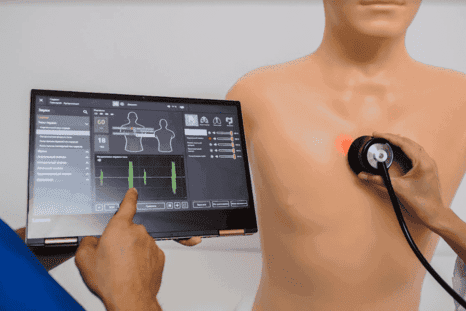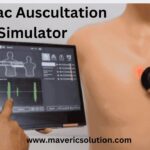The bowel sound simulator is a revolutionary medical training tool designed to aid healthcare professionals in diagnosing and understanding various gastrointestinal conditions. This advanced simulator replicates the sounds produced by the intestines during different stages of digestion and in various pathological states. By providing realistic and diverse bowel sounds, this simulator enhances the diagnostic skills of medical students, nurses, and practicing physicians.
Key Features:
- Realistic Sound Replication: The bowel sound simulator uses high-fidelity audio technology to mimic the normal and abnormal sounds of the gastrointestinal tract. This includes sounds associated with peristalsis, borborygmi (stomach growling), and different bowel obstruction types.
- Variety of Scenarios: Users can experience a range of scenarios, from normal bowel function to various gastrointestinal disorders such as ileus, bowel obstruction, and hyperactive bowel sounds. This variety allows for comprehensive training in recognizing and interpreting bowel sounds.
- Interactive Learning: The simulator often includes an interactive interface where learners can select different patient scenarios, listen to the corresponding bowel sounds, and receive immediate feedback on their diagnostic accuracy. This interactive approach enhances learning and retention.
- Portable and User-Friendly: Designed for ease of use, the bowel sound simulator is typically portable, making it convenient for classroom settings, clinical skills labs, and even at home for remote learning. The user-friendly interface ensures that novice and experienced users can operate it effectively.
Heart Sound Simulator
The heart sound simulator is an indispensable tool in medical education, designed to improve the auscultation skills of healthcare professionals. By accurately replicating the various sounds produced by the heart, this simulator helps diagnose cardiac conditions and understand the complexities of heart function.
Key Features:
- High-Fidelity Heart Sounds: The heart sound simulator produces high-fidelity audio that accurately replicates normal and abnormal heart sounds. This includes sounds such as S1, S2, murmurs, gallops, and clicks, providing a comprehensive auditory experience.
- Wide Range of Pathologies: The simulator covers a broad spectrum of cardiac conditions, from common ones like mitral valve prolapse and aortic stenosis to more complex conditions like hypertrophic cardiomyopathy. This allows users to practice and hone their diagnostic skills across a wide range of scenarios.
- Interactive and Realistic: With an interactive interface, users can select different patient scenarios, listen to the associated heart sounds, and receive feedback on their performance. Some simulators also feature anatomical models or virtual patients to enhance the realism of the training experience.
- Educational Integration: Heart sound simulators are often integrated into medical curriculums, providing students with regular exposure to cardiac auscultation. This repeated practice is crucial for mastering the skill and ensuring accurate diagnosis in clinical settings.
Simulator for Neonatal Resuscitation
The simulator for neonatal resuscitation is a critical training tool for healthcare providers involved in neonatal care. This advanced simulator replicates real-life scenarios where newborns require resuscitation, providing hands-on practice in a safe and controlled environment.
Key Features:
- Realistic Newborn Model: The simulator typically includes a lifelike newborn model that can be programmed to exhibit various conditions requiring resuscitation. This realism helps trainees gain confidence and proficiency in handling actual neonatal emergencies.
- Comprehensive Training Scenarios: Users can practice a wide range of resuscitation techniques, including airway management, chest compressions, and the use of resuscitation equipment. The simulator can replicate different clinical situations, such as asphyxia, prematurity, and congenital anomalies.
- Immediate Feedback and Assessment: The simulator provides real-time feedback on the trainee’s performance, highlighting areas for improvement. This immediate assessment is crucial for refining techniques and ensuring adherence to neonatal resuscitation protocols.
- Multidisciplinary Training: The simulator is designed for use by a multidisciplinary team, including neonatologists, pediatricians, nurses, and respiratory therapists. This collaborative approach ensures that all team members are well-prepared for neonatal emergencies.
By incorporating these advanced simulators into medical training, healthcare professionals can significantly enhance their diagnostic and clinical skills. These tools not only improve individual competency but also contribute to better patient outcomes through more accurate and timely interventions.
For more information: https://www.mavericsolution.com/medical.html



